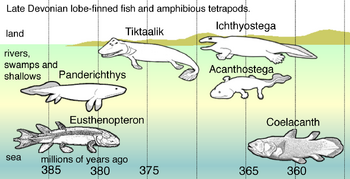| Sarcopterygii Fossil range: Late Silurian – Recent | |
|---|---|
| Scientific classification
| |
|
Superclass |
|
|
Class |
Sarcopterygii |
|
Subclasses |
|
Sarcopterygii - Crossopterygii is traditionally the class of fleshy-finned, lobe-finned fishes, consisting of lungfish, and coelacanths.
Characteristics[]
Sarcopterygians - crossopterygians are bony fish with fleshy-, lobed-paired fins, which are joined to the body by a single bone [1]. These fins evolved into legs of the first tetrapod land vertebrates, amphibians. They also possess two dorsal fins with separate bases, as opposed to the single dorsal fin of actinopterygians (ray-finned fishes). The braincase of sarcoptergygians primitively has a hinge line, but this is lost in tetrapods and lungfish. Many early sarcopts have a symmetrical tail.
Most taxonomists who subscribe to the cladistic approach include the grouping Tetrapoda within this group, which in turns consists of all species of four-limbed vertebrates.[2] The fin-limbs of sarcopterygiians show such a strong similarity to the expected ancestral form of tetrapod limbs that they have been universally considered the direct ancestors of tetrapods in the scientific literature.
Evolution of Sarcopterygii[]

In Late Devonian vertebrate speciation, descendants of pelagic lobe-finned fish — like Eusthenopteron — exhibited a sequence of adaptations:
- Panderichthys, suited to muddy shallows;
- Tiktaalik with limb-like fins that could take it onto land;
- Early tetrapods in weed-filled swamps, such as:
- Acanthostega, which had feet with eight digits,
- Ichthyostega with limbs.
Sarcopterygians are generally accepted to belong to the Osteichthyes group, or bony fishes, characterized by their bony skeleton instead of cartilage. However, due to the vast differences between Sarcopterygii and Osteichthyes in fin structure, respiratory structure, and circulatory structure, some taxonomists are now beginning to consider Sarcopterygii a sister superclass to Osteichthyes, instead of a class below them. The oldest Sarcopterygians were found in the Uppermost Silurian. The first Sarcopterygian closely resembled Acanthodians. The Sarcopterygians closest relatives were the Actinopterygians — ray-finned fishes. Sarcopterygians probably evolved in the oceans, but they later came into freshwater habitats to avoid the predatory placoderms — which were dominant in the Early–Middle Devonian seas.
As Sarcopterygians evolved in the Early Devonian, the line split into two main lineages — the Coelacanths, and the Rhipidistia. The Coelacanths appeared in the Early Devonian, and stayed in the oceans; the coelacanths' heyday was the Late Devonian and Carboniferous, as they were more common during those periods than in any other period in the Phanerozoic. Coelacanths still live today in the oceans. Rhipidistians appeared about the same time as the Coelacanths, but unlike them, Rhipidistians left the ocean world and migrated into the freshwater habitats, their ancestors probably lived in the oceans near the river mouths (estuaries). The Rhipidistians in turn split into two major groups — the lungfishes, and the tetrapodomorphs. The lungfishes' greatest diversity was in the Triassic Period, but today, there are fewer than a dozen genera left. The lungfishes evolved the first proto-lungs and proto-limbs. The lungfishes, ancient and modern, used their stubby fins (proto-limbs) to walk on land and find new water if their waterhole was depleted, and used their lungs to breathe air and get sufficient oxygen.
The tetrapodomorphs have the same identical anatomy as the lungfishes, who were their closest kin, but the tetrapodomorphs appear to have stayed in water a little longer until the Late Devonian. Tetrapods — four legged vertebrates were the terapodomorphs' descendants. Tetrapods appeared in the Late Devonian epoch.
Non-tetrapod sarcopterygians continued to towards the end of Paleozoic Era. They suffered heavy losses during the Permian-Triassic extinction event.
Taxonomy and Phylogeny[]
- Class SARCOPTERYGII
- Actinistia
- †Eoactinistia
- Subclass Coelacanthimorpha
- Order Coelacanthiformes
- Family Latimeriidae
- †Macropoma
- Latimeria
- Family Latimeriidae
- Order Coelacanthiformes
- Rhipidistia
- Subclass Dipnoi
- Order Ceratodontiformes
- Order Lepidosireniformes
- Subclass Tetrapodomorpha
- Order †Rhizodontida
- Superorder †Osteolepidida
- Family †Tristichopteridae
- Order †Osteolepiformes
- Order †Panderichthyida
- †Tiktaalik
- Tetrapoda
- Subclass Dipnoi
- Actinistia
See also[]
- List of Sarcopterygii
- Actinopterygii — ray-finned fishes
References[]
- ^ Clack, J. A. (2002) Gaining Ground. Indiana University
- ^ Nelson, Joseph S. (2006). Fishes of the World. John Wiley & Sons, Inc. ISBN 0-471-25031-7.